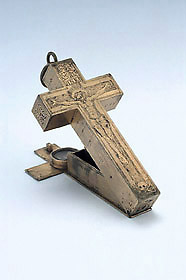
 |
| Catalogue |
 |
 Crucifix Dial The upper section carries the hour lines of a polar dial, where the shadows are cast by the six edges of the top part of the cross on to lines on six rectangular faces. The hour lines are arranged, proceeding counter-clockwise around these faces, 1 to 6, 9 to 12, 6 to 9, 3 to 6, 12 to 3 and 6 to 11. The four square faces carry decorative engraving, the two remaining rectangular ones the signature '[star]M[star]P[star]' and the date '1596'. The upper cross-shaped face has an engraving of Christ of the cross, surmounted by the inscription 'INRI', signifying 'Jesus of Nazareth the King of the Jews', and with a skull and cross-bones at the base. The lower face has an engraving of the brazen serpent on a pole with a top cross-piece. Parts of the box sections could have been used to house relics and one part has been made into a small compartment, possibly for this purpose, though the cover is missing. There is a ring and shackle at the top for wearing the dial around the neck. Jim Bennett |



